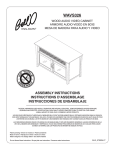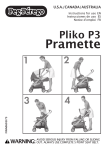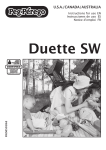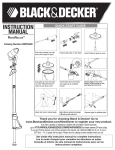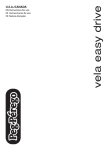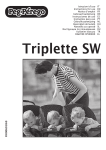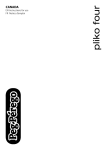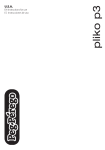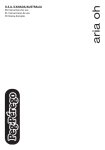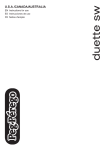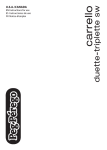Download Peg Perego Uno User's Manual
Transcript
U.S.A./CANADA/AUSTRALIA Instructions for use EN Instrucciones de uso ES Notice dʼemploi FR FINA0702I70 Uno WARNING: AVOID SERIOUS INJURY FROM FALLING OR SLIDING OUT. ALWAYS USE COMPLETE 5 POINT SEAT BELT. A 1 2 3 4 5 6 B A B OK 7 8 9 10 A 11 B C 12 A A B B 13 14 15 16 B A 1 2 3 17 18 19 20 21 22 A 23 24 B A B 25 26 27 28 29 30 31 32 1 2 33 34 35 36 3 A B B 37 38 1 2 39 40 41 42 A 43 44 45 46 47 48 A B 49 Uno+Primo Viaggio "A" 50 Uno+Primo Viaggio "B" 51 Accessory 52 Accessory 53 Accessory Uno 17 18 19 20 13 15 21 25 22 8 14 12 9 28 10 26 24 16 11 5 1 4 6 2 27 23 3 7 Uno 1 SAPI5898DN SAPI5898SN 2 SAPI5904NN 3 SAPI5898KDN SAPI5898KSN 4 SPST4832N 5 SPST4814DN SPST4814SN 6 SPST4748N 7 ERSHVN00--NY01 8 SPST4845DN SPST4845SN 9 SPST4778N 10 SPST4838N 11 SPST4833N 12 SPST4844KNS SPST4844JNS 13 SPST4851N 14 SPST4851AN 15 SPST4848N 16 ASPI0088N 17 MUCI5P14NERO 18 BSAUNO• 19 BCAUNO• 20 BCOUNO• 21 ARPI0434N 22 SAPI6374N 23 ASPI0079L31 24 SAPI5907NN 25 SAPI6430NGR 26 SPST4813JDNPEG SPST4813JSNPEG 27 ITUNONNANL31 28 MMMV0006 EN• Spare parts available in different colours to be specified when ordering. ES• Repuestos disponibles en otros colores que se especificarán en el pedido. FR• Pièces de rechange disponibles en plusieurs couleurs à spécifier dans la demande. EN•ENGLISH • IMPORTANT: read these instructions carefully and keep them for future reference. Failure to follow these instructions could put the childʼs safety at risk. • PEG PEREGO reserves the right to make any necessary changes or improvements to the products shown at any time without notice. CUSTOMER SERVICE If parts of the model are accidentally lost or damaged, use only original Peg Perego spare parts. Contact the Peg Perego Customer Service for all repair work, replacements, information about products, and sale of original spare parts and accessories, at the following: USA: tel.: 800.671.1701 fax: 260.471.6332 Call us toll free: 1.800.671.1701 CANADA: tel.: 905.839.3371 fax: 905.839.9542 Call us toll free: 1.800.661.5050 www.pegperego.com INSTRUCTIONS FOR USE OPENING THE STROLLER 1• To open the stroller, simultaneously press the two buttons on the handlebar, and fix the handlebar in the upright position. Unhook the catches, as shown in the figure. 2• Lift the stroller upwards in one, swift movement and then push it down until the final click, as shown in the figure. ASSEMBLY OF THE STROLLER 3• To attach the handlebar you will need a screwdriver. Unscrew the two screws, taking care not to lose them. 4• Position the handlebar facing the two tubes and push it all the way on. Be careful which way you put the handlebar on. Position it as shown in the figure to avoid putting it on the wrong way. Take care not to bend the cable. 5• Position the screws as shown in the figure, then screw them all the way in with the screwdriver, but without forcing them, on both sides of the handlebar. 6• To mount the big wheels, align with proper fittings and insert the wheels until you hear a click. 7• To mount the basket, press the side buttons and pull to extract the basket rod. 8• Check that the basket bar is properly aligned as indicated in the figure. 9• Slip the rod through the basket fabric. Insert the rod with the basket into its housing, and press until it clicks into place. 10•Fasten the basket sideways to the buttons and before insert the two eyelets in the stroller as indicated in the figure. 11•The stroller basket has three different positions. A: The normal position. B: A lowered position, obtained by pressing the basket down, to allow you to use it even when the backrest is completely lowered. C: Basket raised to allow access to the rear footrest. BRAKE 12•To use the brake on the stroller, pull the lever towards you until it clicks, as shown in the figure. When stationary, always apply the brake. 13• To tighten the brake, turn the REGULATOR on the handlebar outwards, as shown in Figure A. To release and loosen the brake, turn the REGULATOR inwards, as shown in Figure B. SAFETY BELT 14•A: Make sure that the brace is properly inserted by pushing as shown in the figure. B: Fasten the belt as shown in the figure. 15•To unfasten the belt, press on the buckle sides and pull out the waist strap. 16•The new safety belt is now easier to fasten thanks to the "snap-open-andshut" device. Before fastening the safety belt, attach the buckle to the backrest by inserting the tab through the special holder, as shown in the figure. After fastening the safety belt on your child, detach it from the backrest to allow the child more freedom of movement. The buckle must remain below the child's shoulders. ADJUSTING THE BACKREST 17•The backrest reclines to three different positions. To lower the backrest, lift the handlebar and fix the backrest in the desired position. To raise the backrest, pull it upwards. ADJUSTING THE FOOTREST 18•The footrest can be adjusted to two positions. To lower it, pull the two levers downwards while lowering the footrest, as shown in the figure. To raise the footrest, lift it upwards until it clicks into place. SWIVELLING WHEELS 19•The stroller is equipped with two smaller swivelling wheels. To allow the wheels to swivel, raise the lever as indicated in the figure. To lock swivelling, lower the lever. FRONT BAR 20•To insert the front bar-child tray, place it near the housing and push it in until it clicks. 21•The front bar can be moved forward a notch. To do this, push the buttons under the armrests and at the same time pull the front bar out. It is dangerous to put hot drinks on the tray. HANDLEBAR 22•To reverse the handlebar, simultaneously pull the little levers on the handlebar upwards and move the handlebar to the opposite position, pressing until you hear the final click. While carrying out this operation, be very careful not to catch your child's hands or arms. 23•To adjust the handlebar height, press the side buttons simultaneously, as shown in the figure, and lock the handlebar into the desired position. DRINK-HOLDER 24•The drink holder can be placed on the left or right hand side of the stroller, thanks to the attachment which is already fitted on both sides. To fit the drink holder, click it on, as in Figure A. See Figure B for a fitted drink holder. Do not place anything heavier than 1 Kg. (2.2 lbs.) in the drink-holder. BABY CARRIAGE AND/OR STROLLER 25•A) BABY CARRIAGE: Uno becomes a baby carriage when the backrest is lowered to the last position, with the footrest raised, the handlebar positioned opposite the backrest, and the wheels on the same side as the backrest set to swivel. • B) STROLLER: Uno becomes a stroller when the backrest is raised, with the footrest lowered, the handlebar positioned on the same side as the backrest, and the wheels opposite the backrest set to swivel. HOOD 26•The hood is supplied with the front border folded up. It should not be used like this however. In order to be able to use the hood correctly, turn the edge up, as in the figure. 27•To attach the hood, insert the tabs into the special notches on the stroller armrests as shown in the figure, and fasten the hood to the back of the backrest. 28•Fasten the hood to the inner sides of the armrests, stretch out the hood, and press down on the side braces as shown in the figure. 29•To turn the hood into a canopy to shield the child from the sun, open the zipper as shown in the figure and undo the rest of the hood. COVER • To transform Uno into the carriage version, first extend the front bar to the second position and lift the footrest. 30•Slip off the lower part of the hood from under the footrest sack. 31•Insert the tabs on the lower part of the cover into the slots in the front bar. (The slots on the front bar flip out when the front bar is extended. If the slots slide back into their housing, pull the two little levers under the front bar towards you). 32•Insert the side eyelets into the armrests. 33•Baby carriage without cover. 34•Zip the upper part of the cover to the lower part and position the side eyelets in line with the armrests, as shown in the figure. 35•Button the cover to the armrests, as shown in the figure. 36•Carriage version with cover. WHEEL REMOVAL 37•To remove the big wheels press the button (A) as indicated in the figure and slip the wheel (B) off. 38•To remove the small wheels push the lever (A) inward and simultaneously slip the wheel (B) off. CLOSING THE STROLLER Before closing the stroller, check to make sure that the handlebar is positioned on the same side as backrest. If the hood is attached, pull the side braces upwards. Make sure the four wheels are fixed. 39•To close the stroller, lower the righthand lever (marked "1") until it clicks into place. 40•Lower the left-hand lever (marked "2"), and lift the handlebar upwards. 41•Lower the handlebar to finish closing the stroller, and close the catches as shown in the figure. When the UNO stroller is closed, it stands up on its own. TRANSPORT 42•The stroller has a handle on each side, which together allow you to transport it when open (as when going down stairs) or closed. REMOVABLE LINING 43•To remove the lining from the stroller, remove the flaps on the sack from the armrests and unfasten the buttons. 44•Remove the sack flap from the backrest. 45•Loosen the safety belt from both sides, and slip the sack off the stroller. 46•To wash the part below the cover, undo attachments from fittings found on the footrest chassis as indicated in the figure. GANCIOMATIC SYSTEM The Ganciomatic system, thanks to the Ganciomatic connections, is the quick and practical system which allows fastening the Primo Viaggio car seat, also equipped with the Ganciomatc system and sold separately, to the stroller. Primo Viaggio unfastens from its base (which remain in the car) and fastens to the stroller, allowing you to carry the child without disturbing him/her. With the Uno stroller you can fasten the car seat in two different positions (“A” and “B”). STROLLER GANCIOMATIC CONNECTIONS 47•To raise the Ganciomatic connections on the stroller, lift up the lining in the corners of the seat and turn the two connections upwards. 48•To lower the stroller Ganciomatic connections, pull the lever upwards and simultaneously lower the hook as indicated in the figure. • Uno can be closed with the Ganciomatic connections raised. UNO + PRIMO VIAGGIO 49•To fasten the car seat to the stroller in “A” position: - block the stroller with brakes; - remove the stroller hood; - lower the stroller backrest to the second to the lowest position; - raise the stroller Ganciomatic connections; - rotate the handle until it is opposite the backrest; - place the car seat facing the handle; - fasten the car seat, pushing it down until you hear a click. 50•To fasten the car seat to the stroller in “B” position: - block the stroller with brakes; - remove the stroller hood; - lower the stroller backrest to the second to the lowest position; - raise the stroller Ganciomatic connections; - check that the handle is placed on the backrest side; - extend the front bar to the first click; - place the car seat facing the backrest; - fasten the car seat, pushing it down until you hear a click. • To unfasten the car seat from the stroller see the instruction manual. LINE OF ACCESSORIES 51•Rain Canopy: Rain canopy zips onto the hood. 52•This rain canopy is designed so that it can also be used when the Primo Viaggio or Primo Viaggio SIP car seat is attached to the Uno stroller. 53•Diaper-Changing Bag: Satchel with pad for changing babyʼs diaper. Attaches to the stroller. CLEANING & MAINTENANCE Your product requires only minimal maintenance. Cleaning and maintenance operations must be performed only by adults. • Be sure to keep all moving parts clean, lubricating them with light oil if necessary. • Dry off metal parts to prevent rusting. • Regularly clean the plastic parts with a damp cloth. Do not use solvents or similar products. • Brush the fabric parts to remove dust. • Remove any dust and sand from the wheels. • Protect the product against smog, water, rain and snow. Continued and extended exposure to sunlight can change the colours of many materials. • Store the product in a dry area. • To wash the lining, carry out the following instructions. WARNING • THIS PRODUCT IS DESIGNED FOR A CHILD WHOSE MAXIMUM WEIGHT IS 45 POUNDS (20 KG) AND WHOSE MAXIMUM HEIGHT IS 43 INCHES (110 CM). THIS SHOPPER BASKET IS DESIGNED TO CARRY A MAXIMUM WEIGHT OF 11 POUNDS (5 KG). ANY CUPHOLDER EVENTUALLY PROVIDED WITH THIS UNIT IS DESIGNED TO CARRY A MAXIMUM WEIGHT SPECIFIED ON THE CUPHOLDER ITSELF. ANY POACH OR POCKET PROVIDED WITH THIS UNIT IS DESIGNED TO CARRY A MAXIMUM WEIGHT OF 0.44 POUNDS (0.2 KG). • FAILURE TO FOLLOW MANUFACTURERʼS SPECIFICATIONS OR USE OF ACCESSORIES OTHER THAN THOSE APPROVED BY THE MANUFACTURER MAY CAUSE THE UNIT TO BECOME UNSTABLE. • AVOID SERIOUS INJURY FROM FALLING OR SLIDING OUT. ALWAYS USE COMPLETE 5 POINT SEAT BELT. • NEVER LEAVE YOUR CHILD UNATTENDED. • ALWAYS USE ALL THE BRAKES WHENEVER PARKED. • TO AVOID SERIOUS INJURY, WHEN MAKING ADJUSTMENTS ENSURE THE CHILDʼS BODY IS CLEAR OF ALL MOVING PARTS. • ALL OPERATING AND ASSEMBLY PROCEDURES SHOULD BE PERFORMED BY AN ADULT. • DO NOT LIFT THE STROLLER BY GRIPPING THE FRONT BAR. THE FRONT BAR IS NOT DESIGNED TO WITHSTAND LOADS. • ENSURE THAT THE STROLLER IS OPENED CORRECTLY AND LOCKED IN POSITION OF USE. • CHECK TO MAKE SURE THAT THE CAR SEAT OR THE BABY CARRIAGE IS CORRECTLY FASTENED TO THE STROLLER (WHERE APPLICABLE). • DO NOT DRIVE THIS PRODUCT AROUND STAIRS OR STEPS; CARE MUST BE TAKEN IF UNIT IS USED ON STAIRS OR ESCALATORS. • DO NOT USE THE PRODUCT IF IT HAS BROKEN OR MISSING PARTS. • DO NOT USE NEAR FIRE OR EXPOSED FLAME. • NOTICE: THIS ARTICLE MEETS OR EXCEEDS ALL REQUIREMENTS COVERED IN ASTM F833 STANDARD AND LATEST REVISIONS. ES•ESPAÑOL • IMPORTANTE: leer atentamente estas instrucciones y conservarlas para una futura utilización. Si no se siguen estas instrucciones, se podría arriesgar la seguridad del niño. • PEG PEREGO podrá modificar los modelos decritos en este prospecto, por razones técnicas o commerciales. SERVICIO DE ASISTENCIA Si por casualidad alguna parte del modelo se pierde o se rompe, usar sólo piezas de repuesto originales Peg Perego. Para todo lo que concierne las reparaciones, cambios, informaciones sobre los productos y la venta de repuestos originales y accesorios, contacte con el Servicio de Asistencia Peg-Perego: USA: tel.: 800.671.1701 fax: 260.471.6332 Call us toll free: 1.800.671.1701 www.pegperego.com INSTRUCCIONES DE USO APERTURA 1• Para abrir la silla de paseo, presionar al mismo tiempo los dos pulsadores del manillar y bloquearlo en la posición vertical. Desenganchar los acoples como indica la figura. 2• Suba con decisión la silla de paseo hacia arriba y luego empújela hacia abajo hasta el tope final, como indica la figura. CÓMO MONTAR LA SILLA DE PASEO 3• Para montar el manillar hay que quitar con un destornillador los dos tornillos teniendo cuidado de no perderlos. 4• Ponga el manillar de manera que corresponda con los dos tubos empujándolo hasta el fondo. Fíjese en el sentido del manillar y póngalo como muestra la figura para evitar montarlo al contrario; cuidado con no doblar el cable. 5• Ponga el tornillo como muestra la figura y luego atorníllelo con el destornillador, hasta el fondo pero sin forzarlo, en ambos lados del manillar. 6• Para montar las ruedas grandes hay que ponerlas de manera que coincidan con sus alojamientos y meterlas hasta oír clic. 7• Para montar la cesta pulsar los botones laterales y tirar para extraer la varilla de la cesta. 8• Comprobar la correcta colocación de la varilla de la cesta observando la figura. 9• Meter la varilla en el tejido de la cesta. Juntar la varilla con la cesta en su alojamiento hasta que haga clic. 10•Enganchar la cesta lateralmente en los botones y meter por delante los dos ojales a la silla de paseo como indica la figura. 11•La cesta de la silla de paseo tiene tres posiciones. A: posición normal. B: la cesta se baja para que se pueda utilizar también cuando el respaldo está completamente bajado, presionando sobre ella misma, así es más fácil llenarla sin molestar al bebé. C: cesta levantada para acceder al peldaño posterior. FRENO 12•Para frenar la silla de paseo, tire hacia usted la palanca hasta oír clic, como muestra la figura. Cuando la silla está parada, accione siempre el freno. 13• Para apretar el freno, girar el REGULADOR colocado en el manillar hacia afuera, como indica la Figura A. Para aflojar el freno, girar el REGULADOR hacia adentro, como indica la Figura B. CINTURÓN DE SEGURIDAD 14•A: Asegurarse que los tirantes estén correctamente introducidos, empujando tal y como muestra la figura. B: Enganchar el cinturón actuando como muestra la figura. 15•Para desenganchar el cinturón, pulsar en los lados de la hebilla y al mismo tiempo tirar hacia fuera, el cinturón. 16•El nuevo cinturón de seguridad desde hoy es más fácil de poner gracias al sistema “quita y pon”. De hecho, antes de enganchar el cinturón, fije la hebilla pequeña al respaldo introduciendo la lengüeta en la presilla como indica la figura; luego, cuando haya enganchado el cinturón al niño tiene que soltarla del respaldo para dejar que el niño tenga más movilidad. La hebilla pequeña tiene que quedar debajo de los hombros del niño. REGULACIÓN DEL RESPALDO 17•El respaldo de la silla de paseo se puede reclinar en tres posiciones. Para bajarlo hay que subir el asa y al mismo tiempo bloquearlo en la posición deseada; para subirlo hay que empujarlo hacia arriba. REGULACIÓN DEL REPOSAPIÉS 18•El reposapiés se puede regular en dos posiciones. Para bajarlo tirar hacia abajo las dos palanquitas y al mismo tiempo bajar el reposapiés como indica la figura. Para subirlo, levantarlo hacia arriba hasta oír clic. RUEDAS GIRATORIAS 19•La silla de paseo tiene las dos ruedas más pequeñas giratorias. Para que giren hay que levantar la palanca como indica la figura. Para que queden fijas, bajar la palanca. FRONTAL 20•Para colocar la bandeja frontal, acercarla a sus alojamientos y presionar hasta encajarla. 21•La barra frontal puede extenderse una posición más. Para ello, pulsar sobre los botones colocados en la parte inferior de los apoyabrazos y tirar al mismo tiempo de la barra. Es peligroso poner bebidas calientes en la bandeja. MANILLAR 22•Para hacer que el manillar sea reversible tirar hacia arriba las dos palanquitas del manillar al mismo tiempo y ponerlo en la parte opuesta hasta oír clic. Durante esta operación asegurarse de no golpear las manos o los brazos del niño. 23•Para regular la altura del asa, presionar al mismo tiempo los dos pulsadores laterales como indica la figura y bloquear el asa en la posición deseada. PORTABEBIDAS 24•El portabebidas puede colocarse a la derecha o a la izquierda de la silla de paseo gracias a la instalación de puntos de fijación a ambos lados de ésta. Para colocar el portabebidas, presionar sobre él hasta oír un “click” tal y como muestra la imagen A. En la imagen B, un portabebidas colocado. Se aconseja no poner en el portabebidas bebidas calientes ni con un peso superior a 1 Kg (2,2 lbs). COCHECITO Y/O SILLA DE PASEO 25•A: COCHECITO: Uno es un cochecito cuando tiene el respaldo bajado hasta la última posición, el reposapiés levantado, el manillar en la parte opuesta del respaldo y las ruedas giratorias en la parte del respaldo. • B: SILLA DE PASEO: Uno es una silla de paseo cuando tiene el respaldo levantado, el reposapiés bajado, el manillar en la parte del respaldo y las ruedas giratorias en la parte opuesta del respaldo. CAPOTA 26•La capota se entrega con el borde delantero plegado y debe colocarse del mismo modo que se indica en la imagen a fin de asegurar su correcto uso. 27•Para aplicar la capota insertar los acoples en los correspondientes alojamientos de los brazos de la silla de paseo como indica la figura y abrocharla en la parte de detrás del respaldo. 28•Abrochar la capota a los lados internos de los brazos y tensar la capota bajando los compases como indica la figura. 29•Para transformar la capota en toldo parasol, abrir la cremallera como indica la figura y desabrochar la parte de detrás de la capota. CUBREPIES Para transformar Uno en versión cochecito primero hay que alargar la barra frontal hasta la segunda posición y subir el reposapiés. 30•Sacar la parte inferior del cubrepies por debajo del saco del reposapiés. 31•Insertar la lengüeta de la parte inferior del cubrepies en las muescas del frontal. (Las muescas del frontal salen cuando se ensancha el frontal. Si las muescas se meten en su proprio alojamiento hay que empujar hacia sí mismos las dos palanquitas que hay debajo del frontal). 32•Meter los ojales laterales en los reposabrazos. 33•Versión cochecito sin cubrepies. 34•Abrochar con la cremallera la parte superior del cubrepiés con la inferior y ajustar las ranuras laterales a los reposabrazos en secuencia, como indica la figura. 35•Abrochar el cubrepiés a los reposabrazos como indica la figura 36•Modelo cochecito con cubrepies. EXTRACCIÓN DE LAS RUEDAS 37•Para extraer las ruedas grandes pulsar el botón (A) como indica la figura y sacar la rueda (B). 38•Para extraer las ruedas pequeñas empujar hacia dentro la palanca (A) y al mismo tiempo sacar la rueda (B). CIERRE Antes de cerrar la silla de paseo, asegurarse de que: el manillar esté colocado en la parte del respaldo, si está puesta la capota, aflojar los compases y asegurarse de que todas las ruedas estén en la posición fija. 39•Para cerrar la silla de paseo, bajar primero la palanca de la derecha identificada con el número 1, hasta oír clic. 40•Bajar la palanca de la izquierda identificada con el número 2 y subir el manillar hacia arriba. 41•Luego, bajar el manillar hacia abajo y terminar de cerrar, enganchando los acoples como indica la figura. La silla de paseo UNO cerrada se sostiene en pie por sí sola. TRANSPORTE 42•La silla de paseo tiene dos asas de transporte a los lados que permiten transportarla tanto cerrada como abierta (por ej.: para bajar las escaleras). CÓMO SE QUITA LA FUNDA 43•Para quitar la funda de la silla de paseo, extraer las aletas de la funda de los reposabrazos y desabrochar los botones. 44•Quitar la aleta de la funda por el respaldo. 45•Destornillar la correa por ambos lados y sacar el saco. 46•Para poder lavar la parte inferior del cubrepies, sacar los acoples de los alojamientos que hay en el chasis de la plataforma como indica la figura. GANCIOMATIC SYSTEM Ganciomatic System es el sistema práctico y rápido que, gracias a los acoples Ganciomatic, permite acoplar a la silla de paseo la silla de auto Primo Viaggio, dotada también con Ganciomatic System, que se puede comprar por separado. Primo Viaggio se desengancha de su base (que se queda en el coche) y se engancha a la silla de paseo para transportar al niño sin molestar. Con la silla de paseo Uno se puede enganchar la silla de auto de dos maneras diferentes (“A” y “B”). ACOPLES GANCIOMATIC DE LA SILLA DE PASEO 47•Para quitar los enganches Ganciomatic de la silla de paseo, quitar el forro de ésta y girar los dos enganches hacia el exterior. 48•Para bajar los acoples Ganciomatic de la silla de paseo, tirar hacia arriba la palanquita y al mismo tiempo bajar el gancho como indica la figura. • Uno puede cerrarse también con los acoples Ganciomatic subidos. UNO + PRIMO VIAGGIO 49•Para enganchar la silla de auto a la silla de paseo de la MANERA “A” hay que: - frenar la silla de paseo; - quitar la capota de la silla de paseo; - bajar el respaldo de la silla de paseo hasta la penúltima posición; - subir los acoples Ganciomatic de la silla de paseo; - girar el asa por la parte opuesta del respaldo; - poner la silla de auto hacia el asa; - enganchar la silla de auto, empujándola hacia bajo hasta oír clic. 50•Para enganchar la silla de auto a la silla de paseo de la MANERA “B” hay que: - frenar la silla de paseo; - quitar la capota de la silla de paseo; - bajar el respaldo de la silla de paseo hasta la penúltima posición; - subir los acoples Ganciomatic de la silla de paseo; - asegurarse de que el asa esté puesta por la parte del respaldo; - extraer la barra frontal hasta la primera posición; - poner la silla de auto hacia el respaldo; - enganchar la silla de auto, empujándola hacia abajo hasta oír clic. • Para desenganchar la silla de auto de la silla de paseo consultar el manual de instrucciones. LÍNEA DE ACCESORIOS 51•Plástico de lluvia: plástico de lluvia con cremallera que se puede aplicar a la capota mediante la cremallera. 52•Este plástico para la lluvia ha sido diseñado también para cuando a la silla de paseo Uno se le hayan acoplado la silla de auto Primo Viaggio o Primo Viaggio SIP. 53•Bolso con cambiador: bolso con colchoneta para cambiar al bebé, que se puede enganchar a la silla de paseo. LIMPIEZA & MANTENIMIENTO Su producto necesita un mínimo mantenimiento. Las operaciones delimpieza y mantenimiento tiene que ser efectuadas sólo por adultos. • Se aconseja mantener limpias las partes en movimiento y si hiciera falta, lubricarlas con aceite ligero. • Secar las partes de metal del producto para evitar que se oxiden. • Limpiar periódicamente las partes de plástico con un paño húmedo, no usar disolventes ni otros productos parecidos. • Cepillar las partes de tejido para quitar el polvo. • Mantener limpias las ruedas quitando polvo y arena. • Proteger el producto contra los agentes atmosféricos, agua, lluvia o nieve; la exposición continua y prolongada al sol puede causar cambios de color en muchos materiales. • Conservar el producto en un sitio seco. • Para lavar los revestimientos, seguir las indicaciones siguientes. CUIDADO • ESTE PRODUCTO HA SIDO DISEÑADO PARA UN NIÑO CON UN PESO MÁXIMO DE 20 KG Y UNA ALTURA MÁXIMA DE 110 CM. LA CESTILLA HA SIDO REALIZADA PARA SOPORTAR UN PESO MÁXIMO DE 5 KG. LOS POSIBLES PORTABEBIDAS QUE VAN CON ESTE PRODUCTO ESTÁN CONCEBIDOS PARA SOPORTAR EL PESO MÁXIMO ESPECIFICADO EN EL PORTABEBIDAS EN CUESTIÓN. CUALQUIER BOLSA ENTREGADA JUNTO AL PRODUCTO ESTÁ REALIZADA PARA SOPORTAR UN PESO MÁXIMO DE 0,2 KG. • SI NO SE RESPETAN LAS INDICACIONES ESPECIFICADAS O SI SE USAN ACCESORIOS DIFERENTES DE LOS HOMOLOGADOS POR EL FABRICANTE, EL PRODUCTO PUEDE SER INESTABLE. • PARA EVITAR LESIONES GRAVES POR CAÍDAS O SI ESCAPA EL NIÑO DE LA SILLA DE PASEO, USAR SIEMPRE UN CINTURÓN DE SEGURIDAD DE 5 PUNTOS COMPLETO. • NO DEJAR NUNCA AL NIÑO SIN VIGILANCIA. • USAR SIEMPRE TODOS LOS DISPOSITIVOS DE BLOQUEO CADA VEZ QUE LA SILLA DE PASEO NO ESTÉ EN MOVIMIENTO. • PARA EVITAR LESIONES GRAVES, ASEGURARSE DE QUE EL NIÑO NO PUEDA MOVERSE PELIGROSAMENTE MIENTRAS SE REGULA EL PRODUCTO. • TODAS LAS OPERACIONES DE ENSAMBLAJE DEBE REALIZARLAS SOLO UN ADULTO. • NO LEVANTAR LA SILLA DE PASEO COGIÉNDOLA POR LA BARRA FRONTAL. LA BARRA FRONTAL NO HA SIDO CONCEBIDA PARA SOPORTAR PESOS. • ASEGURARSE DE QUE LA SILLA DE PASEO ESTÉ ABIERTA CORRECTAMENTE Y BLOQUEADA EN LA POSICIÓN CORRECTA PARA SU UTILIZACIÓN. • ASEGURARSE DE QUE LA SILLA DE AUTO O EL COCHECITO ESTÉN ENGANCHADOS CORRECTAMENTE A LA SILLA DE PASEO. • NO USAR LA SILLA DE PASEO CERCA DE ESCALERAS O ESCALONES; PRESTAR ATENCIÓN CUANDO SE UTILIZA EN ESCALERAS O ESCALERAS MECÁNICAS. • NO UTILIZAR EL PRODUCTO SI PRESENTA PARTES DAÑADAS O SI FALTA ALGUNA PARTE. • NO USAR EN PRESENCIA DE LLAMAS O FUENTES DE CALOR. • AVISO: ESTE PRODUCTO CUMPLE SUFICIENTEMENTE CON TODOS LOS REQUISITOS ESTABLECIDOS POR LA NORMA ASTM F833 Y ULTERIORES REVISIONES. FR•FRANÇAIS • IMPORTANT : lire ces instructions avec attention et les conserver pour toute référence future. ILa sécurité de votre enfant pourrait être menacée si ces instructions ne sont pas respectées. • Pour des raisons techniques et commerciales, PEG PEREGO pourra apporter à tout moment des modifications aux modèles décrits dans ce manuel. SERVICE DʼASSISTANCE En cas de perte ou dommage fortuit de pièces du modèle, utilisez exclusivement les pièces de rechange originales Peg Perego. Pour les éventuelles réparations, substitutions, informations sur les produits, la vente de pièces de rechange originales et dʼaccessoires, contactez le Service dʼassistance Peg-Perego: CANADA: tel.: 905.839.3371 fax: 905.839.9542 Call us toll free: 1.800.661.5050 www.pegperego.com NOTICE DʼEMPLOI OUVERTURE 1• Pour ouvrir la poussette, appuyer simultanément sur les deux boutons du guidon, bloquer ce dernier à la verticale. Décrocher les fixations comme indiqué sur la figure. 2• Soulever énergiquement la poussette puis la pousser vers le bas jusquʼà entendre le déclic, comme indiqué sur la figure. 3• 4• 5• 6• 7• ASSEMBLAGE DE LA POUSSETTE Pour monter la poignée, il convient, à lʼaide dʼun tournevis, de dévisser les deux vis en prenant garde de ne pas les perdre. Faire coïncider la poignée avec les deux montants et lʼinsérer complètement. Faire attention au sens de la poignée, la positionner comme sur la figure en évitant ainsi de la monter en sens contraire. Prendre garde de ne pas plier le câble. Positionner la vis comme indiqué sur la figure, puis visser complètement à lʼaide dʼun tournevis mais sans forcer, de chaque côté de la poignée. Pour monter les grandes roues, les positionner de manière à ce quʼelles coïncident avec lʼemplacement prévu et les insérer jusquʼà entendre un clic. Pour monter le panier, appuyer sur les boutons latéraux et tirer pour faire sortir la tige du panier. 8• Vérifier le bon positionnement de la barre du panier en se référant à la figure. 9• Introduire la tige dans le tissu du panier. Insérer la tige assemblée au panier dans son logement, jusqu'à entendre un déclic. 10•Accrocher les côtés du panier aux boutons et, à lʼavant, accrocher les deux œillets à la poussette, comme sur la figure. 11•Le panier de la poussette est réglable en trois positions. A: position normale. B: le panier sʼabaisse pour pouvoir lʼutiliser même lorsque le dossier est complètement abaissé ; en appuyant sur celui-ci, il est plus facile de le remplir sans déranger le bébé. C: panier relevé pour accéder au reposepied arrière. FREIN 12•Pour actionner le frein de la poussette, tirer le levier vers soi jusquʼà entendre le déclic, comme indiqué sur la figure. À lʼarrêt, toujours actionner le frein. 13• Pour régler le frein et le rendre plus dur, dévisser vers lʼextérieur le DISPOSITIF DE RÉGLAGE situé sur la poignée, comme indiqué sur la figure A. Pour desserrer et assouplir le frein, visser vers lʼintérieur le DISPOSITIF DE RÉGLAGE, comme indiqué sur la figure B. CEINTURES DE SECURITE 14•A: Assurez-vous que la bretelle soit correctement insérée en vérifiant comme indiqué sur le schéma correspondant. B: Accrochez la ceinture comme indiqué sur le schéma. 15•Pour détacher la ceinture, appuyez de chaque côté de la boucle et tirez pour que les deux parties se désolidarisent. 16•Grâce à son système de fixation particulier, la nouvelle ceinture de sécurité est désormais plus pratique à attacher. En effet, avant dʼattacher la ceinture, fixer la boucle au dossier en insérant la languette dans le passant prévu à cet effet, comme indiqué sur la figure. Après avoir attaché la ceinture, la détacher du dossier pour permettre au bébé de bouger en toute liberté. La boucle doit rester sous les épaules du bébé. REGLAGE DU DOSSIER 17•Le dossier de la poussette est inclinable en trois positions. Pour lʼabaisser, soulever la poignée tout en bloquant le dossier dans la position souhaitée. Pour le relever, le pousser vers le haut. REGLAGE DU REPOSE-PIED 18•Le repose-pied est réglable en deux positions. Pour l'abaisser, tirer les deux doigts vers le bas tout en abaissant le repose-pied, comme indiqué sur la figure. Pour le relever, le soulever jusqu'à entendre le déclic dʼenclenchement. ROUES PIVOTANTES 19•Les roues les plus petites de la poussette sont pivotantes. Pour que les roues deviennent pivotantes, relever le levier, comme sur la figure. Pour quʼelles soient fixes, abaisser le levier. BARRE FRONTALE 20•Pour insérer la barre frontale-plateau, la positionner en correspondance des logements prévus à cet effet et lʼinsérer jusquʼà entendre le déclic. 21•La barre frontale peut être allongée dʼun cran. Pour lʼallonger, appuyer sur les boutons situés sous les accoudoirs tout en tirant la barre frontale vers lʼextérieur. Il est dangereux de poser des boissons bouillantes sur le plateau. GUIDON 22•Pour inverser le guidon, tirer simultanément vers le haut les deux doigts situés sur le guidon et amener le guidon du côté opposé jusquʼà entendre le déclic dʼenclenchement. Au cours de cette opération, sʼassurer de ne pas heurter les mains ou les bras de lʼenfant. 23•Pour régler la hauteur du guidon, appuyer simultanément sur les deux boutons latéraux, comme indiqué sur la figure, et bloquer le guidon dans la position souhaitée. PORTE-BOUTEILLE 24•Le porte-boissons peut être appliqué sur le côté gauche ou droit de la poussette grâce au crochet déjà présent de chaque côté de la poussette. Pour appliquer le porte-boissons, lʼaccrocher en prêtant attention au déclic, comme indiqué sur la figure A. Porte-boissons accroché, figure B. Il est conseillé de ne pas insérer des boissons chaudes et pesant plus de 1 kg (2,2 lbs) dans le porte-bouteille. POUSSETTE VENEZIA VERSION A ET B 25•A: Uno est en version A lorsque le dossier est abaissé jusquʼen dernière position, le repose-pied relevé, le guidon du côté opposé au dossier et les roues pivotantes du côté du dossier. • B: Uno est en version B lorsque le dossier est relevé, le repose-pied abaissé, le guidon du côté du dossier et les roues pivotantes du côté opposé au dossier. CAPOTE 26•La capote est fournie avec la bordure repliée. Elle ne doit cependant pas être utilisée en lʼétat. Rabattre la bordure comme indiqué sur la figure pour pouvoir utiliser la capote correctement. 27•Pour appliquer la capote, insérer les fixations dans les logements appropriés des accoudoirs de la poussette, comme indiqué sur la figure, et la boutonner à lʼarrière du dossier. 28•Boutonner la capote aux flancs internes des accoudoirs et tendre la capote en abaissant les petits leviers, comme indiqué sur la figure. 29•Pour transformer la capote en pare-soleil, ouvrir la fermeture Eclair comme indiqué sur la figure et déboutonner le reste de la capote. TABLIER Pour transformer Uno en version landau, allonger tout dʼabord la barre frontale jusquʼà atteindre la deuxième position puis relever la pédale repose-pieds. 30•Détacher la partie inférieure du tablier par le dessous de la housse du repose-pieds. 31•Insérer les languettes de la partie inférieure du tablier dans les fentes de la barre frontale. (Les fentes de la barre frontale sortent lorsque cette dernière est rallongée. Si les fentes rentraient dans leur logement, pousser vers soi les deux doigts situés sous la barre frontale). 32•Insérer les œillets latéraux dans les accoudoirs. 33•Version sans tablier. 34•À lʼaide de la fermeture éclair, unir la partie supérieure du tablier à sa partie inférieure. Insérer les boutonnières latérales sur les accoudoirs dans les passants correspondants, comme indiqué sur la figure. 35•Boutonner le tablier aux accoudoirs, comme indiqué sur la figure. 36•Version landau avec tablier. DEMONTAGE DES ROUES 37•Pour démonter les grandes roues, appuyer sur le bouton (A), comme sur la figure, et retirer les roues (B). 38•Pour démonter les petites roues, pousser vers lʼintérieur le levier (A) et, en même temps, retirer les roues (B). FERMETURE Avant de fermer la poussette, sʼassurer que le guidon est du côté du dossier. Si la capote est appliquée, desserrer les petits leviers et sʼassurer que toutes les roues sont en position fixe. 39•Pour fermer la poussette, abaisser tout dʼabord le levier de droite portant le chiffre 1, jusquʼà entendre le déclic dʼenclenchement. 40•Abaisser le levier de gauche portant le chiffre 2 et tirer le guidon vers le haut. 41•Abaisser ensuite le guidon et fermer la poussette en accrochant les fixations comme indiqué sur la figure. Une fois fermée, la poussette UNO reste debout toute seule. TRANSPORT 42•La poussette est dotée de deux poignées latérales qui permettent de la transporter POUR RETIRER LA HOUSSE 43•Pour retirer la housse de la poussette, détacher les ailettes de la housse des accoudoirs et la déboutonner. 44•Retirer lʼailette de la housse du dossier. 45•Dévisser la ceinture des deux côtés et retirer la housse. 46•Pour nettoyer la partie inférieure du tablier, détacher les fixations sur le cadre du repose-pieds, comme indiqué sur la figure. ; - relever les fixations Ganciomatic de la poussette ; - sʼassurer que le guidon est positionné du côté du dossier ; - faire ressortir la barre frontale jusquʼà entendre le premier clic ; - positionner le siège auto en le tournant vers le dossier ; - accrocher le siège auto en le poussant vers le bas, jusquʼà entendre un clic. • Pour décrocher le siège auto de la poussette, consulter son manuel dʼinstructions. SYSTÈME GANCIOMATIC LIGNE D'ACCESSOIRES Grâce aux fixations Ganciomatic, le système Ganciomatic permet dʼaccrocher facilement et rapidement le siège auto Primo Viaggio (également équipé du système Ganciomatic) à la poussette. Le siège auto Primo Viaggio est vendu séparément. Primo Viaggio peut être décroché de sa base (qui reste dans la voiture) et accroché à la poussette pour transporter lʼenfant sans le déranger. Avec la poussette Uno, il est possible dʼaccrocher le siège auto de deux façons différentes (« A » et « B »). 51•Habillage pluie: habillage pluie avec fermeture éclair qui se zippe sur la capote de la poussette. 52•Cette bâche a également été étudiée pour une utilisation sur la poussette Uno avec le siège auto Primo Viaggio ou Primo Viaggio SIP. 53•Sac à langer: Sac muni dʼun petit matelas pour changer bébé, qui peut être monté sur la poussette. tant fermée quʼouverte (ex.: pour descendre les escaliers). FIXATIONS GANCIOMATIC DE LA POUSSETTE 47•Pour soulever les fixations Ganciomatic de la poussette, relever la housse au niveau des angles de lʼassise et orienter les deux fixations vers le haut. 48•Pour abaisser les fixations Ganciomatic de la poussette, tirer la languette vers le haut et, dans le même temps, abaisser le crochet, comme sur la figure. • Uno peut aussi être refermée lorsque les fixations Ganciomatic sont relevées. UNO + PRIMO VIAGGIO 49•Pour accrocher le siège auto à la poussette en MODE « A », il faut : - actionner le frein de la poussette ; - enlever la capote de la poussette ; - baisser le dossier de la poussette en le positionnant sur lʼavant-dernière position ; - relever les fixations Ganciomatic de la poussette ; - tourner le guidon du côté opposé au dossier ; - positionner le siège auto en le tournant vers le guidon ; - accrocher le siège auto en le poussant vers le bas, jusquʼà entendre un clic. 50•Pour accrocher le siège auto à la poussette en MODE « B », il faut : - actionner le frein de la poussette ; - enlever la capote de la poussette ; - baisser le dossier de la poussette en le positionnant sur lʼavant-dernière position NETTOYAGE ET ENTRETIEN Votre produit nécessite un minimum dʼentretien. Les opérations de nettoyage et dʼentretien doivent être effectuées uniquement par des adultes. • Il est recommandé de maintenir toutes les parties mobiles propres et, au besoin, de les lubrifier avec une huile légère. • Essuyer les parties métalliques du produit pour prévenir la formation de rouille. • Nettoyer régulièrement les parties en plastique avec un chiffon humide, ne pas utiliser de solvants ou dʼautres produits du même type. • Brosser les parties en tissu pour les dépoussiérer. • Éliminer les dépôts de poussière et de sable des roues. • Protéger le produit contre les agents atmosphériques, lʼeau, la pluie ou la neige; lʼexposition continue et prolongée au soleil pourrait altérer les couleurs de nombreux matériaux. • Conserver le produit dans un endroit sec. • Pour le lavage du sac, suivre les instructions ci-après. AVERTISSEMENT • CE PRODUIT A ETE CONÇU POUR UN ENFANT DONT LE POIDS NʼEXCEDE PAS 20 KG (45 LIVRES) ET LA TAILLE NE DEPASSE PAS 110 CM (43 POUCES). LE PANIER A ETE CONÇU POUR SUPPORTER DES CHARGES MAXIMALES DE 5 KG (11 LIVRES). LE PORTEBOISSONS EVENTUELLEMENT FOURNI AVEC LE PRODUIT A ETE CONÇU POUR SUPPORTER DES CHARGES INDIQUEES SUR LE PORTE-BOISSONS LUI-MEME. LES POCHETTES OU SACS FOURNIS AVEC CE PRODUIT ONT ETE CONÇUS POUR SUPPORTER DES CHARGES MAXIMALES DE 0,2 KG (0,44 LIVRES). • LE DEFAUT DʼOBSERVATION DES SPECIFICATIONS DU FABRICANT OU LʼEMPLOI DʼACCESSOIRES NON APPROUVES PAR LE FABRICANT PEUT AFFECTER LA STABILITE DU PRODUIT. • POUR ÉVITER DE GRAVES BLESSURES SUITE À LA CHUTE OU AU GLISSEMENT DE LʼENFANT DU PRODUIT, TOUJOURS UTILISER UNE CEINTURE DE SÉCURITÉ À 5 POINTS COMPLÈTE. • NE JAMAIS LAISSER LʼENFANT SANS SURVEILLANCE. • TOUJOURS ACTIONNER LES FREINS LORSQUE LE PRODUIT EST A LʼARRET. • POUR ÉVITER DE GRAVES BLESSURES LORS DU RÉGLAGE DU PRODUIT, SʼASSURER QUE LES MEMBRES DE LʼENFANT NE SONT PAS EN CONTACT AVEC DES PIÈCES EN MOUVEMENT. • LʼENSEMBLE DES PROCÉDURES DE MONTAGE ET DʼUTILISATION DOIT ÊTRE EFFECTUÉ PAR UN ADULTE. • NE PAS SOULEVER LA POUSSETTE PAR LA BARRE FRONTALE. ELLE NʼA PAS ÉTÉ CONÇUE POUR SUPPORTER DES CHARGES. • SʼASSURER QUE LA POUSSETTE EST CORRECTEMENT OUVERTE EST BLOQUÉE DANS LA POSITION CONVENANT À SON UTILISATION. • CONTRÔLER QUE LE SIÈGE ENFANT OU LE LANDAU EST CORRECTEMENT ACCROCHÉ À LA POUSSETTE. • NE PAS UTILISER CE PRODUIT À PROXIMITÉ DE MARCHES OU DʼESCALIERS; PRÊTER ATTENTION À LA MANIPULATION DU PRODUIT DANS DES ESCALIERS OU DES ESCALATORS. • NE PAS UTILISER LE PRODUIT SI DES PIÈCES SONT MANQUANTES OU CASSÉES. • NE PAS UTILISER PRÈS DU FEU OU DʼUNE FLAMME DIRECTE. • REMARQUE : CET ARTICLE REMPLIT LES CONDITIONS REQUISES PAR LA NORME ASTM F833 ET RÉVISIONS RÉCENTES OU SATISFAIT À DES CONDITIONS PLUS SÉVÈRES. Uno PEG PEREGO S.p.A. VIA DE GASPERI 50 20043 ARCORE MI ITALIA tel. 0039•039•60881 fax 0039•039•615869-616454 Servizio Post Vendita - After Sale: tel. 0039•039•6088213 fax: 0039•039•3309992 PEG PEREGO U.S.A. Inc. 3625 INDEPENDENCE DRIVE FORT WAYNE INDIANA 46808 phone 260•482•8191 fax 260•484•2940 Call us toll free 1•800•671•1701 PEG PEREGO CANADA Inc. 585 GRANITE COURT PICKERING ONTARIO CANADA L1W3K1 phone 905•839•3371 fax 905•839•9542 Call us toll free 1•800•661•5050 www.pegperego.com 14-06-2007
This document in other languages
- français: Peg Perego Uno
- español: Peg Perego Uno

























